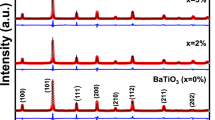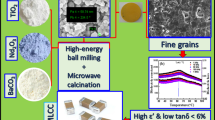Abstract
A series of lead-free perovskite-structured dielectric ceramics of (1-x)Ba0.6Sr0.4Ti0.7Zr0.3O3-xBi(Li0.5Ta0.5)O3 ((1-x)BSTZ-xBLT, x = 0, 0.10, 0.15, and 0.20) were prepared through solid-state reaction method combined with conventional sintering. Specifically, for x = 0, 0.10, 0.15, and 0.20, the samples of (1-x)BSTZ-xBLT were sintered in air for 8 h at 1500 °C, 1300 °C, 1200 °C, and 1150 °C, respectively. All samples possess a pure perovskite structure and achieve a high relative density of 93 ~ 95%. The average grain size of all samples falls within 1.74 ~ 2.67 μm, and all composition elements distribute uniformly. The addition of BLT is conducive to reduce the sintering temperature of BSTZ. The critical electric field corresponding to the saturation polarization intensity of BSTZ increases from 69.4 kV/cm to 88.9 kV/cm as x rises from 0 to 0.10. The dielectric permittivity of 0.85BSTZ-0.15BLT and 0.80BSTZ-0.20BLT keeps stable (∆\(\varepsilon\)/\(\varepsilon\) 25 °C ≤ ± 15%) in the test temperature of − 100 ~ 350 °C. The activation energy (\(E\)α) of BSTZ enhances from 0.86 eV to 1.72 eV as x rises from 0 to 0.20, which contributes to the broadening of the band gap. These results suggest that (1-x)BSTZ-xBLT ceramics are promising candidates for high-temperature ceramic capacitors.










Similar content being viewed by others
Data availability
The data presented in this study are available upon request from the corresponding author.
References
S.Y. Zhou, Y.P. Pu, X.Y. Zhao, O. Tao, J.M. Ji, Dielectric temperature stability and energy storage performance of NBT-based ceramics by introducing high-entropy oxide. J. Am. Ceram Soc. 105, 4796–4804 (2022). https://doi.org/10.1111/jace.18455
X.L. Chen, G.S. Huang, D.D. Ma, G.F. Liu, H.F. Zhou, High thermal stability and low dielectric loss of BaTiO3-Bi(Li1/3Zr2/3)O3 solid solution. Ceram. Int. 43, 926–929 (2017). https://doi.org/10.1016/j.ceramint.2016.10.099
M. Jia, X. Chen, W.O. Yang, J. Wang, H. Li, J. Fang, Microstructure, dielectric, and energy storage properties of BaTiO3 ceramics prepared via cold sintering. Ceram. Int. 44, 4436–4441 (2018). https://doi.org/10.1016/j.ceramint.2017.12.044
Z. Chen, F. Chen, X. Zhong, Z. Ling, Z. Tang, G. Jian, Enhanced ferroelectric relaxor behavior of Ho2O3-modified barium zirconate titanate ceramics. J. Mater. Sci. Mater. Electron. 29, 16730–16739 (2018). https://doi.org/10.1007/s10854-018-9766-9
X. Tang, K. Wang, K. Chew, W. Chan, Relaxor behavior of (Ba, Sr)(Zr, Ti)O3 ferroelectric ceramics. Solid State Commun. 136, 89–93 (2005). https://doi.org/10.1016/j.ssc.2005.06.034
X.L. Chen, X. Li, J. Sun, C. Sun, J. Shi, F. Pang, H. Zhou, Simultaneously achieving ultrahigh energy storage density and energy efficiency in barium titanate based ceramics. Ceram. Int. 46, 2764–2771 (2020). https://doi.org/10.1016/j.ceramint.2019.09.265
W.B. Li, D. Zhou, R. Xu, L.X. Pang, M. Reaney, BaTiO3-Bi(Li0.5Ta0.5)O3, lead-free ceramics, and multilayers with high energy storage density and efficiency. ACS Appl. Energy Mater. 1, 5016–23 (2018). https://doi.org/10.1021/acsaem.8b01001
J. Li, J. Liu, M.S. Zeng, Z.F. He, H.Q. Li, Y. Yuan, S. Zhang, High efficiency and power density relaxor ferroelectric Sr0.875Pb0.125TiO3-Bi(Mg0.5Zr0.5)O3 ceramics for pulsed power capacitors. J. Eur. Ceram. Soc. 40, 2907–16 (2020). https://doi.org/10.1016/j.jeurceramsoc.2020.03.037
L. Zhang, L. Pang, W. Li, D. Zhou, Extreme high energy storage efficiency in perovskite structured (1–x)(Ba0.8Sr0.2)TiO3-xBi(Zn2/3Nb1/3)O3 (0.04 ≤ x ≤ 0.16) ceramics. J. Eur. Ceram. Soc. 40, 3343–47 (2020). https://doi.org/10.1016/j.jeurceramsoc.2020.03.015
C.Y. Luo, Y. Wei, Q. Feng, M. Wang, N.N. Luo, C.L. Yuan, C. Zhou, T. Fujita, J.W. Xu, Significantly enhanced energy-storage properties of Bi0.47Na0.47Ba0.06TiO3-CaHfO3 ceramics by introducing Sr0.7Bi0.2TiO3 for pulse capacitor application. Chem. Eng. J. 429, 1321–65 (2022). https://doi.org/10.1016/j.cej.2021.132165
R.D. Shannon, Revised effective ionic radii and systematic studies of interatomic distances in halides and chalcogenides. Acta Crystallogr. A 32, 751–767 (1976). https://doi.org/10.1107/S0567739476001551
J. Cyd, Effects of sintering temperature on the dielectric and piezoelectric properties of Sr additive Sm-modified PbTiO3 ceramics. Sensor Actuat A-Phys. 102, 6–10 (2002). https://doi.org/10.1016/S0924-4247(02)00382-5
H. Di, Z.B. Pan, X.Y.T.F. Yang, J. Ding, X. Zhang, P. Li, J.J. Liu, J. Zhai, H. Pan, Optimization the energy density and efficiency of BaTiO3-based ceramics for capacitor applications. Chem. Eng. J. 409, 1273–1275 (2021). https://doi.org/10.1016/j.cej.2020.127375
Q. Xu, M. Chen, W. Chen, H.X. Liu, B.H. Kim, B.K. Ahn, Effect of CoO additive on structure and electrical properties of (Na0.5Bi0.5)0.93Ba0.07TiO3 ceramics prepared by the citrate method. Acta. Mater. 56, 642–50 (2008). https://doi.org/10.1016/j.actamat.2007.10.014
L.N. Shi, Y.G. Wang, Z.H. Ren, A. Jain, S.S. Jiang, F.G. Chen, Significant improvement in electrical characteristics and energy storage performance of NBT-based ceramics. Ceram. Int. 48, 26973–26983 (2022). https://doi.org/10.1016/j.ceramint.2022.06.009
H.R. Ye, F. Yang, Z.B. Pan, D. Hu, X.J. Lv, H. Chen, F.F. Wang, J.S. Wang, P. Li, J.W. Chen, J.J. Liu, J. Zhai, Significantly improvement of comprehensive energy storage performances with lead-free relaxor ferroelectric ceramics for high-temperature capacitors applications. Acta Mater. 203, 1164–1184 (2021). https://doi.org/10.1016/j.actamat.2020.116484
J. Chen, Y. Wang, L. Wu, Q. Hu, Y. Yang, Effect of nanocrystalline structures on the large strain of LiNbO3 doped (Bi0.5Na0.5)TiO3-BaTiO3 materials. J. Alloys Compd. 775, 865–871 (2018). https://doi.org/10.1016/j.jallcom.2018.10.195
Q. Xu, T.M. Li, H. Hao, S.J. Zhang, Z.J. Wang, Enhanced energy storage properties of NaNbO3 modified Bi0.5Na0.5TiO3 based ceramics. J. Eur. Ceram. Soc. 35, 545–553 (2015). https://doi.org/10.1016/j.jeurceramsoc.2014.09.003
W.B. Hu, Z. Chen, Z. Lu, X. Wang, X.F. Fu, Effect of Bi2O3 and Ho2O3 co-doping on the dielectric properties and temperature reliability of X8R BaTiO3-based ceramics. Ceram. Int. 47, 24982–24987 (2021). https://doi.org/10.1016/j.ceramint.2021.05.226
T.Y. Li, Z.L. Qiao, R.Z. Zuo, X9R-type Ag1-3BiNbO3 based lead-free dielectric ceramic capacitors with excellent energy-storage properties. Ceram. Int. 48, 2533–2537 (2022). https://doi.org/10.1016/j.ceramint.2021.10.035
X. Li, X.L. Chen, H.F. Zhou, J. Sun, X.X. Li, Phase evolution, microstructure, thermal stability and conductivity behavior of (Ba1-xBi0.67xK0.33x)(Ti1-xBi0.33xSn0.67x)O3 solid solutions ceramics. J. Alloys Compd. 777, 1066–1073 (2019). https://doi.org/10.1016/j.jallcom.2018.11.129
Q. Xu, M.T. Lanagan, X.C. Huang, J. Xie, L. Zhang, H. Hao, Dielectric behavior and impedance spectroscopy in lead-free BNT-BT-NBN perovskite ceramics for energy storage. Ceram. Int. 42, 9728–9736 (2016). https://doi.org/10.1016/j.ceramint.2016.03.062
Z. Li, H.Q. Fan, Polaron relaxation associated with the localized oxygen vacancies in Ba0.85Sr0.15TiO3 ceramics at high temperatures. J. Appl. Phys. 106, 054–102 (2009). https://doi.org/10.1063/1.3211308
X. Qiao, F. Zhang, D. Wu, B. Chen, X. Zhao, Z.H. Peng, X. Ren, P. Liang, X.L. Chao, Z. Yang, Superior comprehensive energy storage properties in Bi0.5Na0.5TiO3-based relaxor ferroelectric ceramics. Chem. Eng. J. 388, 1241–58 (2020). https://doi.org/10.1016/j.cej.2020.124158
Funding
This research was supported by the National Natural Science Foundation of China (52262018), Yunnan Provincial Natural Science Key Foundation (202201AS070032), Yunnan Major Scientific and Technological Projects (202202AG050016), Yunnan Ten Thousand Talents Plan Young & Elite Talents Project (YNWR-QNBJ-2018–176), and National Undergraduate Training Programs for Innovation and Entrepreneurship (20211067400136).
Author information
Authors and Affiliations
Contributions
All authors contributed to the experimental design, data analysis, and manuscript organization. WL and BM designed the experimental plan, performed research, analyzed data, and wrote the paper. QY and XP analyzed the XRD data and revised the English grammar. CF, HZ, and YC reviewed and edited the manuscript at different stages.
Corresponding authors
Ethics declarations
Conflict of interest
The authors have no competing interest to declare that are relevant to the content of this article.
Additional information
Publisher's Note
Springer Nature remains neutral with regard to jurisdictional claims in published maps and institutional affiliations.
Rights and permissions
Springer Nature or its licensor (e.g. a society or other partner) holds exclusive rights to this article under a publishing agreement with the author(s) or other rightsholder(s); author self-archiving of the accepted manuscript version of this article is solely governed by the terms of such publishing agreement and applicable law.
About this article
Cite this article
Lin, W., Yang, Q., Meng, B. et al. Microstructure and dielectric properties of Bi(Li0.5Ta0.5)O3-modified Ba0.6Sr0.4Ti0.7Zr0.3O3-based ceramics. J Mater Sci: Mater Electron 34, 554 (2023). https://doi.org/10.1007/s10854-023-10015-7
Received:
Accepted:
Published:
DOI: https://doi.org/10.1007/s10854-023-10015-7




